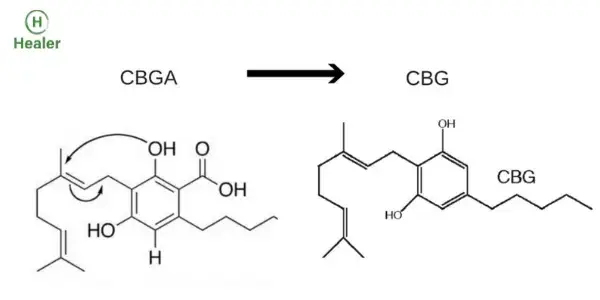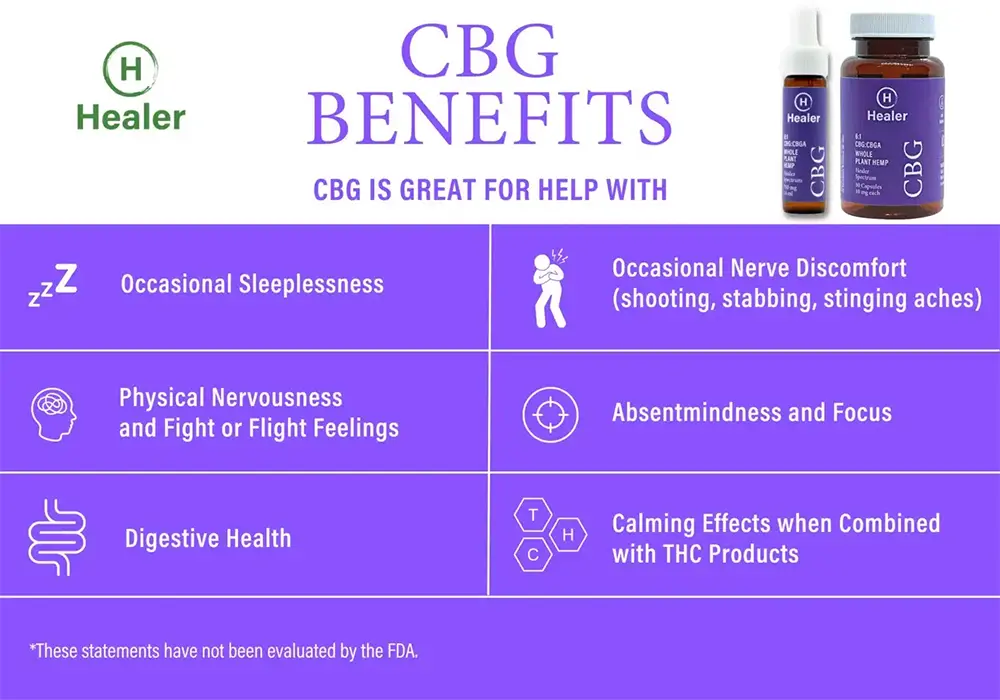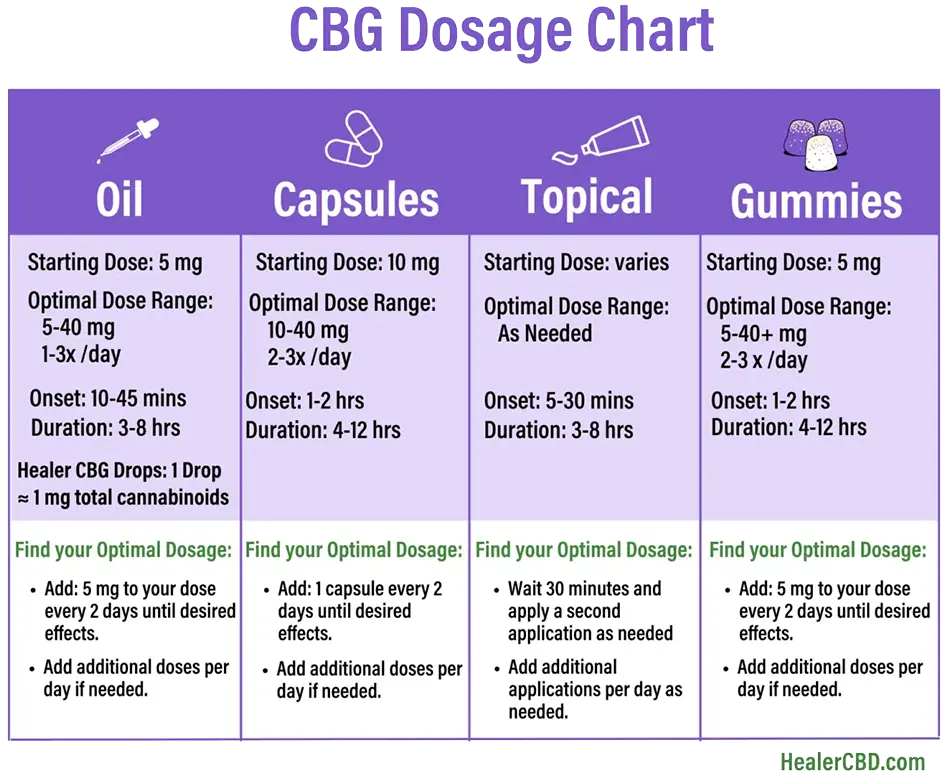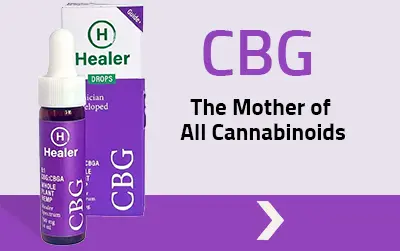Like the other cannabinoids, CBG has the potential to help with a wide range of health concerns, including*:
- Trouble sleeping
- Nerve pain with shooting and stinging discomfort
- Physical anxiety and fight or flight feelings
- Attention deficit and hyperactivity
- Inflammation
- GI health
Understanding CBG: The Basics
CBG, like CBD and THC, is one of over 100 cannabinoids found in the cannabis plant. It is often referred to as the “mother cannabinoid” or “stem cell” of cannabinoids because it is the precursor to both CBD and THC. In the early stages of the plant’s growth, CBG is the first cannabinoid synthesized by the cannabis plant’s enzymes.
How is CBG Different from CBD and THC?
Unlike THC, CBG is non-intoxicating, meaning it doesn’t produce the psychoactive effects typically associated with cannabis consumption. This makes CBG an attractive option for individuals seeking the potential therapeutic benefits of cannabinoids without the euphoric high.

CBG differs from CBD in its molecular structure and potential effects. While both cannabinoids have been studied for their anti-inflammatory, analgesic, and neuroprotective properties, CBG may have a more direct impact on the endocannabinoid system due to its affinity for cannabinoid receptors.
Exploring the Potential Benefits of CBG*
Research into the therapeutic potential of CBG is still in its infancy, but early studies suggest a wide range of possible benefits:
Pain Relief: CBG has shown promise as a potential analgesic, with studies indicating its ability to alleviate pain and inflammation. This makes it a compelling option for individuals suffering from conditions such as arthritis or neuropathic pain.
“In one rodent study of peripheral inflammatory pain, CBG was shown to be much more potent than THC and aspirin [1]. CBG was effective at 1.26 mg/kg; aspirin reduced pain at 15 mg/kg, and THC worked at 25 mg/kg. While THC’s maximal pain reduction was better (THC had the potential for stronger relief at much higher doses), this data suggests CBG could be a cost-effective agent for pain, effective at low doses without the impairment possibility related to THC.” Healer
CBG and Glaucoma Management: Some research suggests that CBG may help reduce intraocular pressure, making it a potential treatment for glaucoma, a condition that can lead to vision loss if left untreated.
“Repetitive administration of CBG, and to a lesser extent, single doses reduced eye pressure in cats. The intraocular pressure (IOP) of CBG-treated eyes was 4-8 mmHg lower than the untreated eye on the other side. That’s a significant reduction that could be important in the treatment for glaucoma. Also, CBG was shown not to be toxic to the eye or optic nerve [2]. This is especially important for patients with glaucoma who want to use a hemp product, because CBD has the potential to raise IOP, something that should be avoided – for those with this condition, CBG, THC, and CBDA are better choices than CBD.” Healer
Neuroprotective Properties: CBG may offer neuroprotective effects, potentially making it valuable in the treatment of neurodegenerative diseases like Parkinson’s and Alzheimer’s.
Anti-Inflammatory Effects: Like other cannabinoids, CBG exhibits anti-inflammatory properties, which could make it beneficial for conditions characterized by inflammation, such as inflammatory bowel disease (IBD) and arthritis.
Antibacterial and Antifungal Activity: CBG has demonstrated antibacterial and antifungal properties in laboratory studies, suggesting potential applications in the treatment of bacterial and fungal infections.
CBG and Inflammatory Bowel Disease
One mouse model of ulcerative colitis found that CBG was protective and curative based on the overall reduction of the ratio between colon weight to length, a measure of disease severity [3]. This model of colitis is known to increase several inflammatory cytokines and decrease anti-inflammatory IL-10 levels, and CBG was shown to restore these to normal levels in the study. Through another method of action, CBG provided antioxidant protection of the cells in the intestines. Based on these early findings, there could be a lot of promise for CBG helping with inflammatory bowel disease.
From Healer:
Benefits of CBG vs. CBD
Compared to CBD, early indicators suggest CBG is:
- More calming and relaxing
- Effective for aches and discomfort not addressed by CBD
- More potent at lower doses
- Unlikely to diminish the effects of THC
Is it good to mix CBG with CBD and CBDA?
Some evidence suggests that large amounts of CBG may inhibit some of the benefits of CBD and CBDA, via their opposite effects on the serotonin system. I have not yet observed this clinically, but it is possible for some people that adding high doses of CBG to an effective CBD/CBDA regimen might decrease some of the benefits of CBD/CBDA.
Conversely, CBDA is not likely to inhibit the effects of CBG, and even small amounts of CBDA may enhance the benefits of CBG.
CBG Dosage Guide – How to Use CBG Effectively
The key to getting the best outcomes with CBG is to use the right dosage that’s suited to your specific needs. Specifically, this means that to get the most out of CBG, you’ll need to figure out what your specific ideal dose is and how often you should take it.
I recommend starting with CBG drops administered sublingually (beneath the tongue). Some of the medicine will be absorbed quickly into your circulation through the network of capillaries in your mouth, providing rapid relief, while the remainder will be digested and provide a delayed impact.
Furthermore, consuming CBG in this manner allows you the fine tuning required to determine your unique ideal usage amount. This is especially true with Healer brand drops which are formulated to contain about 1 mg of cannabinoids per drop. As a result, drops are far and away the most cost-effective option.
Taking CBG drops such as Healer’s 6:1 CBG:CBGA with food containing some healthy fat will increase absorption, which can increase the treatment’s effectiveness while lowering its cost.
I recommend most people start with 5mg twice daily and gradually work up to 40mg per dose if needed. Most people report noticing the effects quickly (even after a single dose) and also describe increasing benefits over the first 30 days of consistent use. CBG has a mild, pleasant flavor, quite different from the peppery taste of CBDA.
If you’re currently using CBD or CBDA formulas to address health conditions, but want to test how CBG compares, I recommend trying CBG products at least 4 hours apart from your CBD or CBDA dosages, to learn how you respond to CBG. After establishing how you respond to CBG on its own, I encourage you to use CBG, CBD, and CBDA in the regimen that works best for you.
As scientists continue to unlock the mysteries of CBG, its role in health and wellness may become increasingly significant, offering new possibilities for individuals seeking natural alternatives to traditional pharmaceuticals. However, further research is needed to fully understand CBG’s effects and its potential applications in clinical settings.
[1] Formukong, E. A., A. T. Evans, and F. J. Evans. “Analgesic and antiinflammatory activity of constituents of Cannabis sativa L.” Inflammation 12.4 (1988): 361-371.
[2] Colasanti, Brenda K., Charles R. Craig, and R. David Allara. “Intraocular pressure, ocular toxicity and neurotoxicity after administration of cannabinol or cannabigerol.” Experimental eye research 39.3 (1984): 251-259.
[3] Borrelli, Francesca, et al. “Beneficial effect of the non-psychotropic plant cannabinoid cannabigerol on experimental inflammatory bowel disease.” Biochemical pharmacology 85.9 (2013): 1306-1316
*Disclaimer: These statements have not been evaluated by the U.S. Food and Drug Administration. These products are not intended to diagnose, treat, cure or prevent any disease. The information is for educational purposes and is not a substitute for or alternative to information from your healthcare providers.





